The Watchung Reservation History Trail is a 6-mile trail that visits and identifies sites of historic interest in Union County’s Watchung Reservation, a 2,000+acre preserve located in the northern portion of the County. The Reservation is an integral part of the Union County Parks system, designed by the Olmsted Brothers of Brookline, Mass., the celebrated landscape architects who designed New York’s Central Park and scores of other notable public lands.
The stops along the History Trail recall features from the early years of the Watchung Reservation, or describe uses of the land before it was incorporated into the park. The trail is marked with pink blazes, with signs on posts along the trail identifying the location of each site. The trail is designed to start and end at the Trailside Nature & Science Center, but can also be accessed from parking areas at the Deserted Village of Feltville and Lake Surprise.
This virtual version of the trail (www.ucnj.org/wrht) is designed so that people with disabilities can also experience the trail. It also includes features enabling hikers to identify trees and animal life encountered along the way.
You can also view a special version of this on your mobile device by going to www.ucnj.org/mobile-trails and by scanning the QR codes along the trail.
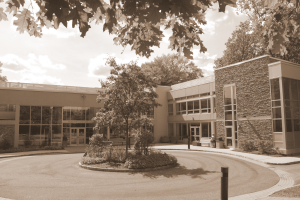
In 1941, a small nature display was set up on a table in the corner of a plant nursery maintenance garage. It was so popular that the whole building was quickly given over to exhibits and became the Trailside Museum, a name that came from the National Park Service’s model for museums located next to trails.
The building was expanded in 1952. In 1961, the facility was renamed the Trailside Nature & Science Center, and a Planetarium was constructed alongside the Museum in 1969.
A modern Visitor Center, designed by nationally renowned architect Michael Graves, was erected uphill from the older buildings in 1975, and that building was expanded in 2006.
Today, this environmental education facility is perhaps the oldest surviving trailside museum in the United States. It is open daily from noon to 5:00 p.m.
Copper Mine
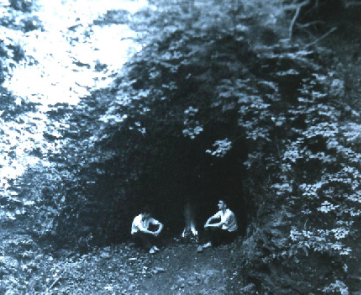 Exploration for copper in this area of the First Watchung Mountain may date back to at least the 1600’s. Crushed ore may have been used for tools and decoration by the Lenape tribe of Native Americans.
Exploration for copper in this area of the First Watchung Mountain may date back to at least the 1600’s. Crushed ore may have been used for tools and decoration by the Lenape tribe of Native Americans.
Another story holds that Hessian soldiers held captive near here by the Colonial Army during the Revolutionary War were compelled to dig for copper ore to support the war effort. The ore was of low quality and the exploratory mine never progressed more than 15 feet into the mountain.
Portions of the mine have collapsed and are visible to the north of the gorge. On the edge of the collapsed area, a large stone used for sluicing the ore can be seen.
Feltville Mill
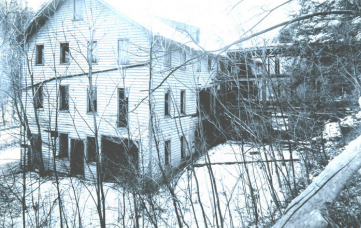 In 1845, David Felt built a 3½ story mill, powered by water from the Blue Brook, to serve as a factory for his printing business, Stationers Hall Press.
In 1845, David Felt built a 3½ story mill, powered by water from the Blue Brook, to serve as a factory for his printing business, Stationers Hall Press.
Felt built an entire town, Feltville, on the bluff overlooking the mill to house his workers. A 3-bay garage next to the mill housed ox-drawn wagons that carried Felt’s stationary products to his store in New York City.
The mill was torn down in 1930.
Hermit’s Pond
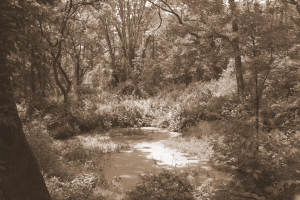 This spring-fed pond was built about 1882 by Warren Ackerman to supply water to the guests of his summer resort, Glenside Park.
This spring-fed pond was built about 1882 by Warren Ackerman to supply water to the guests of his summer resort, Glenside Park.
A house was built uphill from the pond for the man, who came to be known as the Hermit, who was responsible for operating a steam-driven pump and steam laundry at the pond.
Seeley’s Pond
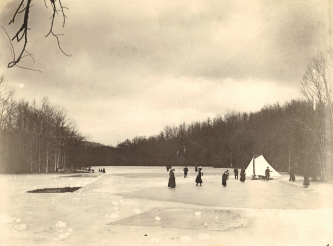 If you’re in the mood to add another mile to your hike—the History Trail is six miles and at this point, you’re about a a third of the way along—then just after you pass the ruins of the Drake House, you will reach the intersection with the Sierra Trail (white blazes). Head west on the trail and you will reach Seeley’s Pond, one of the most popular picnicking spots in the Reservation.
If you’re in the mood to add another mile to your hike—the History Trail is six miles and at this point, you’re about a a third of the way along—then just after you pass the ruins of the Drake House, you will reach the intersection with the Sierra Trail (white blazes). Head west on the trail and you will reach Seeley’s Pond, one of the most popular picnicking spots in the Reservation.
Just as with Lake Surprise, which was used to power the mill in Feltville(Site 6), Seeley’s Pond was also created by damming the Blue Brook in order to power another mill.
In the late 1800s, Edmund A. Seeley founded a paper manufacturing company and used the falls for power. Once the waters flow over the Seeley’s Pond dam, they soon join up with the Green Brook, which eventually drains into the Raritan River.
Drake Farm House & Barn
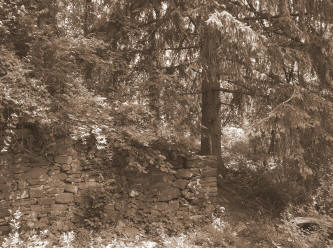 Six hundred acres of open land along the Second Watchung Mountain were farmed to provide food for the residents of the mill town of Feltville.
Six hundred acres of open land along the Second Watchung Mountain were farmed to provide food for the residents of the mill town of Feltville.
Later, the land was used by Warren Ackerman for cattle grazing and by the guests of the summer resort of Glenside Park for their recreational pursuits, including golf.
Even after this land was incorporated into the Watchung Reservation in the 1920’s, a portion of this land was farmed by the Drake family up until the 1940’s. The stone foundations of the Drake Farm house and barn are still visible.
Deserted Village of Feltville/Glenside Park
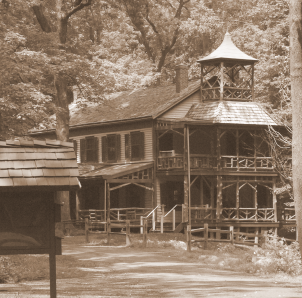 About 1736, Peter Willcocks built a sawmill along the Blue Brook to produce lumber, which would be needed by farmers as they settled this frontier area. The sawmill operation cleared hundreds of acres of forest.
About 1736, Peter Willcocks built a sawmill along the Blue Brook to produce lumber, which would be needed by farmers as they settled this frontier area. The sawmill operation cleared hundreds of acres of forest.
In 1845, David Felt bought 760 acres of land and built a printing factory along the brook. He built an entire town on the bluff above the brook to support the mill operation, and by 1850, 175 people were living in Feltville. After Felt retired in 1860, other business ventures were tried but failed, and the town became deserted for a short time.
But in 1882, Warren Ackerman bought the property and converted the former mill town into a summer resort, called Glenside Park. When the popularity of mountain resorts was displaced by the advent of the Jersey Shore, Glenside Park closed in 1916.
Soon after the Union County Park System was formed in 1921, this area was incorporated into the Watchung Reservation, one of America’s first county parks. The grounds of the Deserted Village are open daily during daylight hours.
There is a pamphlet available for a walking tour that explains the ten surviving historic buildings, some of which are still inhabited. The pamphlets outlining the walking tour through the Deserted Village, with some additional history, are usually available at the brown kiosks, one in the parking lot just off Glenside Avenue, and the other just past the General Store/Church. The pamphlet is also available online.
Boy Scout Camporee Field
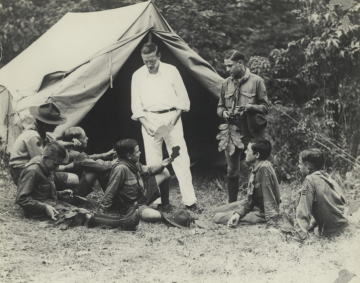 This field was used by Boy Scouts for tent camping until Interstate Route 78 was built nearby in 1985. The State and Federal governments paid to relocate Scout camping activities away from the highway, to the other side of the park.
This field was used by Boy Scouts for tent camping until Interstate Route 78 was built nearby in 1985. The State and Federal governments paid to relocate Scout camping activities away from the highway, to the other side of the park.
When Lake Surprise was restored in 2000, the 52,000 cubic yards of sediment that was dredged from the lake was disposed of here and at the adjoining Corn Field. These fields are now the largest wildflower meadows in Union County.
Corn Field
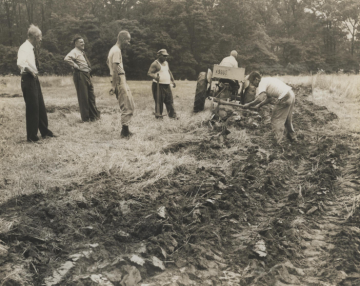 This field is named for the crop that was grown here when the area was still farmland. In the woods below the Corn Field, the Elizabeth area Boy Scouts built their first official camp, including a log mess hall and three-sided lean-to cabins, in the 1920’s.
This field is named for the crop that was grown here when the area was still farmland. In the woods below the Corn Field, the Elizabeth area Boy Scouts built their first official camp, including a log mess hall and three-sided lean-to cabins, in the 1920’s.
Until the formation of the Union County Park Police a few years later, the Boy Scouts patrolled the trails of the Watchung Reservation, helping lost hikers and picking up litter. The log mess hall has since been demolished. The lean-tos were replaced with newer structures in the 1960’s, but are no longer in use.
Lake Surprise
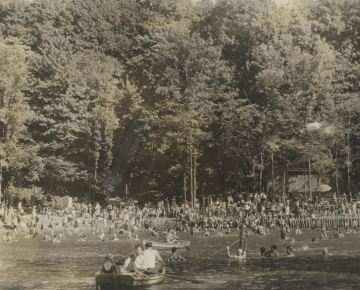 In 1845, David Felt built a secondary water source for powering his mill at Feltville by damming the Blue Brook. Feltville Lake was renamed Ackerman Lake when the summer resort of Glenside Park opened.
In 1845, David Felt built a secondary water source for powering his mill at Feltville by damming the Blue Brook. Feltville Lake was renamed Ackerman Lake when the summer resort of Glenside Park opened.
By the time the Union County Park Commission bought the property for inclusion in the Watchung Reservation, the lake was called Silver Lake and was a popular place for swimming and boating.
The park planners laid out a road to the lake that wound its way down through the woods such that the lake could not be seen until you were right next to it. Hence the new name – Lake Surprise.
Girl Scout Cabin
 One of the favorite adventures for area Girl Scouts was the Girl Scout Cabin built on a bluff overlooking the lake.
One of the favorite adventures for area Girl Scouts was the Girl Scout Cabin built on a bluff overlooking the lake.
Click here to see an old newspaper clipping from the Oct. 8, 1964 issue of the Cranford Citizen and Chronicle. Under the column for Garwood Girl Scout News is an item about how a new Junior Troop was forming that would meet at St. Anne’s School and that “the girls are planning a day camping trip to the Girl Scout Cabin at Surprise Lake.”
The cabin was destroyed by fire in 1975 & St. Ann’s School has since closed.
Lake Surprise Boathouse
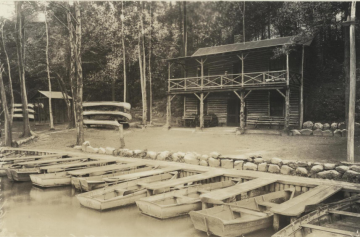 By 1930, park users could rent rowboats at a rustic boathouse along the southern shore of Lake Surprise. Nearby was a refectory where park visitors could buy refreshments.
By 1930, park users could rent rowboats at a rustic boathouse along the southern shore of Lake Surprise. Nearby was a refectory where park visitors could buy refreshments.
A restroom building stood on the hillside up behind the boathouse, where it could also serve park visitors from the Loop Area parking lot. All three buildings were dismantled by the 1970’s. Boats are still allowed on Lake Surprise, with the proper permit decal (call 908-527-4900).
Lake Surprise Bathhouse
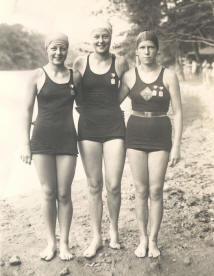 In the early years of the Watchung Reservation, park visitors could swim at a beach on the southern shore of the lake, and could change into swimsuits at a bathhouse.
In the early years of the Watchung Reservation, park visitors could swim at a beach on the southern shore of the lake, and could change into swimsuits at a bathhouse.
Aquatic carnivals at the lake drew hundreds of participants for swimming and boating events. Lifeguards kept watch from a tower in the middle of the lake
Badgley House
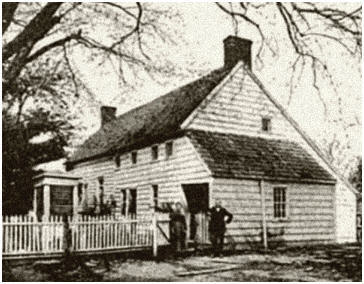 In 1736, Peter Willcocks built a sawmill along the Mo-No-Pe-Nonck Indian trail, near the Blue Brook. He built a house on the Second Watchung Mountain. At the same time, his in-laws, the Badgleys, built a house along that same trail on the First Watchung Mountain.
In 1736, Peter Willcocks built a sawmill along the Mo-No-Pe-Nonck Indian trail, near the Blue Brook. He built a house on the Second Watchung Mountain. At the same time, his in-laws, the Badgleys, built a house along that same trail on the First Watchung Mountain.
Over the next 250 years, the house was a residence, horse riding stable, and maintenance garage. About 1907, the Badgley house was moved about 250′ north and set onto a high foundation. After the house was moved, it was converted to a barn for a riding stable, which operated into the 1940’s.
Sadly, the house was destroyed by a fire set by an arsonist in 1984. However, a depression in the lawn at the nearby Scout Camping Area reveals the location of the original house.
Road from Westfield to New Providence
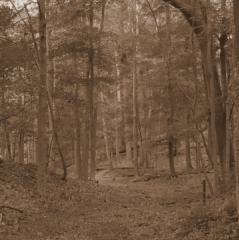 The former Mo-No-Pe-Nonck trail used by Lenape Indians grew into the Road from Westfield to New Providence as farmers settled this area of the West Fields beyond Elizabethtown.
The former Mo-No-Pe-Nonck trail used by Lenape Indians grew into the Road from Westfield to New Providence as farmers settled this area of the West Fields beyond Elizabethtown.
The road still exists outside of the park as New Providence Road in Mountainside and Glenside Road in Berkeley Heights, and in sections inside the park as hiking or bridle trails.
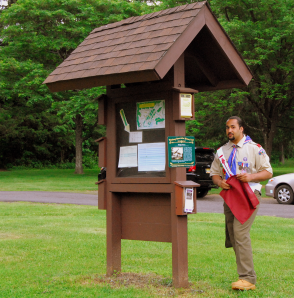 History of the History Trail
History of the History Trail
The Watchung Reservation History Trail was an Eagle Scout project, designed and executed by Robert Gruytch of Roselle Park. Gruytch, with the help of adults and scouts from Troop 56 in Roselle Park, logged 322 hours in creating the six-mile trail.
He completed the project during his junior and senior years, graduating from Roselle Park High School in 2010. He is going into his sophomore year at Montclair University, where he is majoring in astrophysics. He hopes to work for NASA.
The project was a perfect fit for him. “I have a love for hiking,” he said, following the trail’s dedication on National Trails Day, June 4, 2011. “I did my first hike for hiking merit badge up here in the reservation.”
His favorite part of the hike is just north of the Drake House (Site 5ab) where there is a stand of evergreen trees. “The smell. The scenery. They’re just beautiful,” he said.
